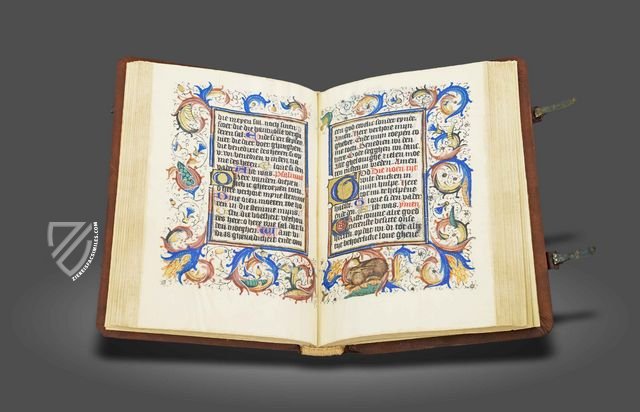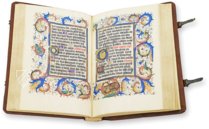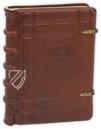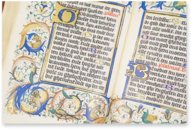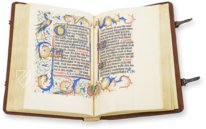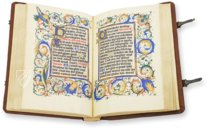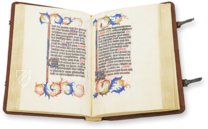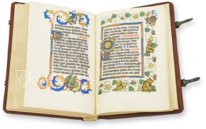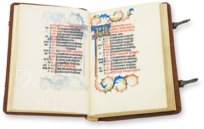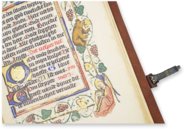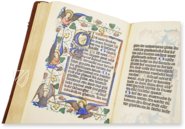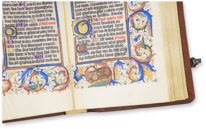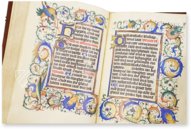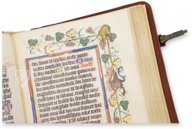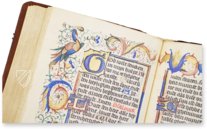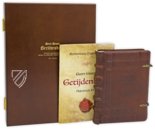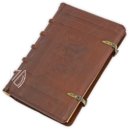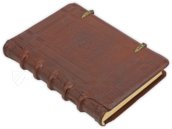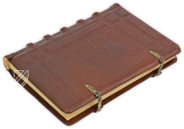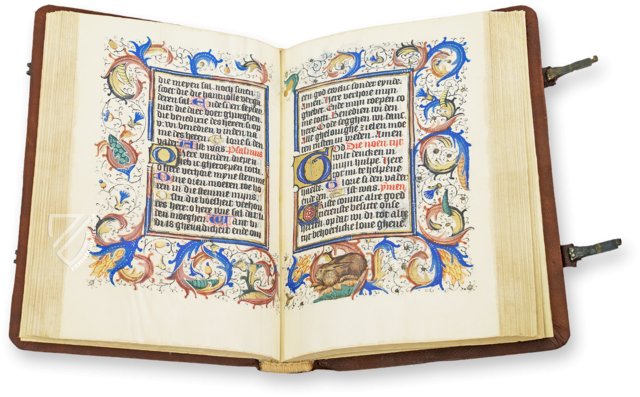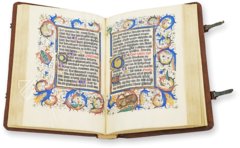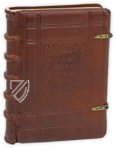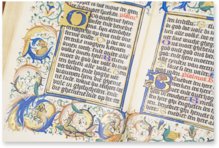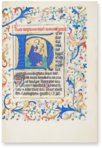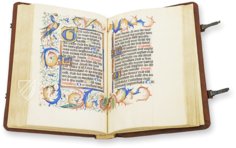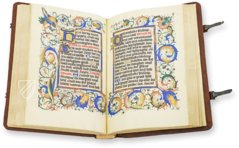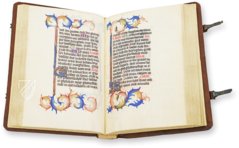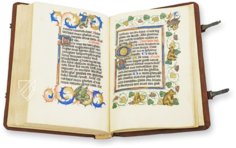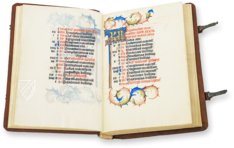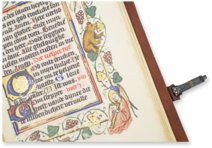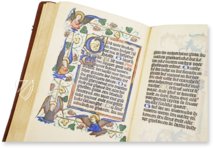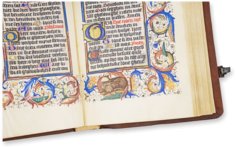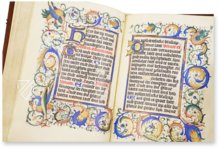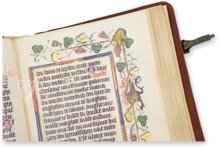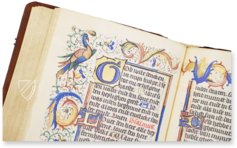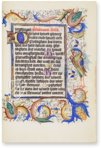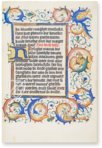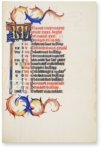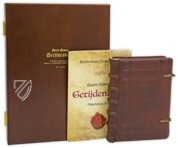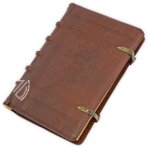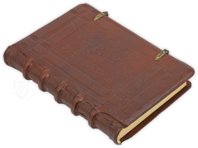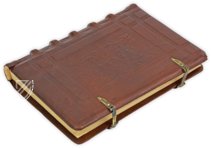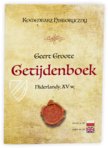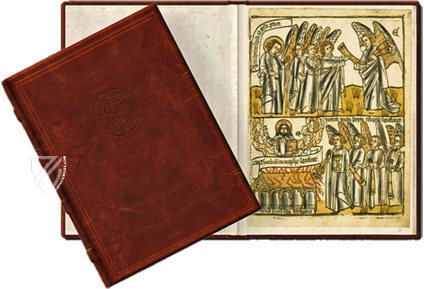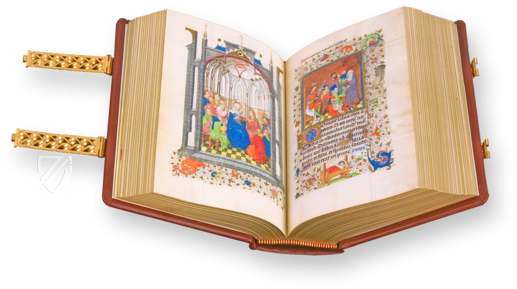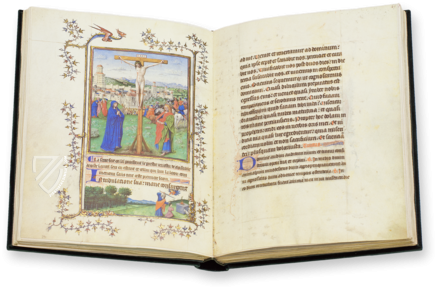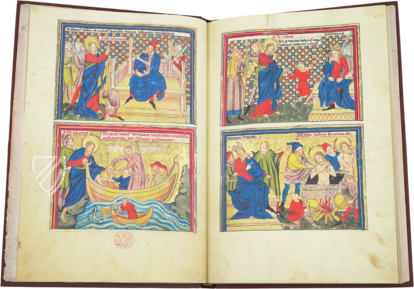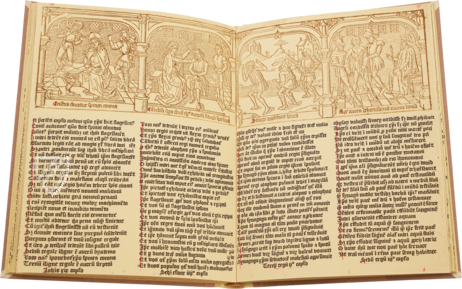Geert Groote - Getijdenboek
(1,000€ - 3,000€)
One of the most valuable calendars of the Middle Ages originated from the Netherlands in the mid–15th century. It is the calendar of the Diocese of Utrecht. Aside from an annual calendar, it also contains a transcript of the Getijdenboek, a manuscript by the Dutch theologian and preacher Geert Groote. Every page of the manuscript is adorned with colored and sometimes gilded initials, as well as splendid floral bordures and figural decorative elements.
Geert Groote – Getijdenboek
Historic annual calendars rarely limited themselves to a pure depiction of the course of the year, but rather gave information about the season-dependent activities, the weather conditions expected in the course of the year gives the best day for the cutting of hair, bathing, bleeding, weaning, etc. In Christianity, the term calendar indicates an official directory for church feasts and commemoration days. In the Middle Ages, the calendar reached the broadest levels of the population in a way that few other types of reading material had and were always used for practical and economical use, but also as edifying and moral instruction. The Getijdenboek by the Dutchman Geert Groote was made for the Utrecht Diocese and is one of the most beautiful examples of this manuscript genre. Practically every page of the parchment manuscript illuminated with gorgeously colored and gilded initials, as well as floral and figurative patterns. Today, the precious original specimen of the work is in the university library of Nicolaus Copernicus in the Polish city of Torun.
The Gifted Author Geert Groote
Geert Groote was a Dutch theologian and preacher of repentance. He was born the son of the wealthy merchant Werner Grote and his wife Heylwig van der Basselen. Both of his parents died of plague when he was ten years old. Orphaned at an early age, he attended the chapter school of the Utrecht Hochstift and at the age of 15 began his studies at the Sarbonne in Paris, where he came into contact with the great philosophers and scholars of his time. He was particularly influenced by the writings of the famous medieval preacher and mystic Bernard of Clairvaux. Groote led a dissolute life in his youth. Moved by a meeting with Heinrich von Calcar, a close friend and Carthusian monk, he decided one day for a pious and virtuous life in a monastery in Dutch Arnhem. Here the educated and well-read monk inter alia made his handwritten calendar for the Diocese of Utrecht.
Enchanting Illumination
The Utrecht calendar consists of two book parts, which were combined by a scribe in the mid–15th century. The second part of the work is a transcript of the Getijdenboek by Groote, the first part contains the annual calendar. The uniform script of the original work is still easily legible today. Each page is adorned with unique, stunningly colored and gilded initials. The borders of the pages are furnished with elaborate bordures of flowering tendrils and figurative patterns. These special elements of décor clearly show the influence of Renaissance illumination, which the anonymous illuminators were guided by in their work. The binding of the manuscript is equally characteristic for the time period. It consists of dark-brown leather embossed with a pattern as well as two brass clasps, which protect the pages of the book from dust and dirt.
Codicology
- Alternative Titles
- Brewiarz Staroniderlandzki
Kalendarium der Diozöse Utrecht - Size / Format
- 258 pages / 20.0 × 14.5 cm
- Origin
- Netherlands
- Date
- Mid 15th century
- Epochs
- Style
- Genre
- Language
- Illustrations
- Almost each page has unique and very beautifully colored and gilded initials, as well as borders with floral and figural decorations
- Artist / School
- Jacobus (bookbinder)
- Previous Owners
- National and University Library in Królewiec
Geert Groote – Getijdenboek
Marginalia with Drolleries
Many medieval artists indulged their creativity in the margins of the manuscripts they created, an artistic space in which they were given free reign. The marginalia of this page is ripe with giant bunches of grapes and animals both real and fantastic. A fat bear can be seen feasting in the corner, but below him we see a strange hybrid creature, a so-called drollery. Its pink front half resembles a dragon, complete with a horned head, but its rear half appears to be that of a common ox.
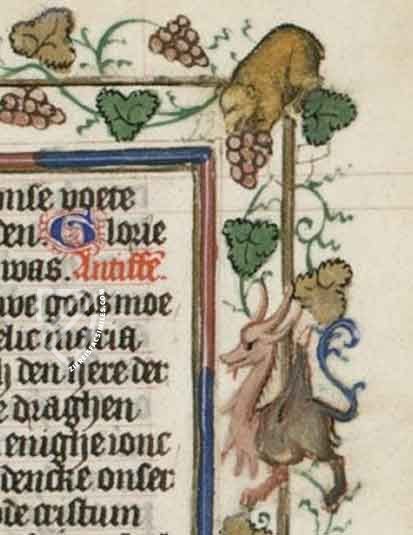
Geert Groote - Getijdenboek
Angelic Text Page
This exemplary page from Geert Groote’s book of hours is a fine example of 15th century Dutch illumination, and these decorative borders are found throughout this wonderful manuscript. Various angels with round cheeks, serene expressions, and outstretched wings populate the marginalia. Their torsos appear from blue clouds, as though they are breaking through into our mortal plane.
This page’s tendrils alternate between succulent bunches of grapes and leaves of green and gold – the harvest is nigh. Delicate shades of pink and blue are incorporated throughout the page, especially the frame, which is broken up on the upper-left side to allow room for the blue and gold initial. Halos and initials in the text are highlighted with gold leaf.
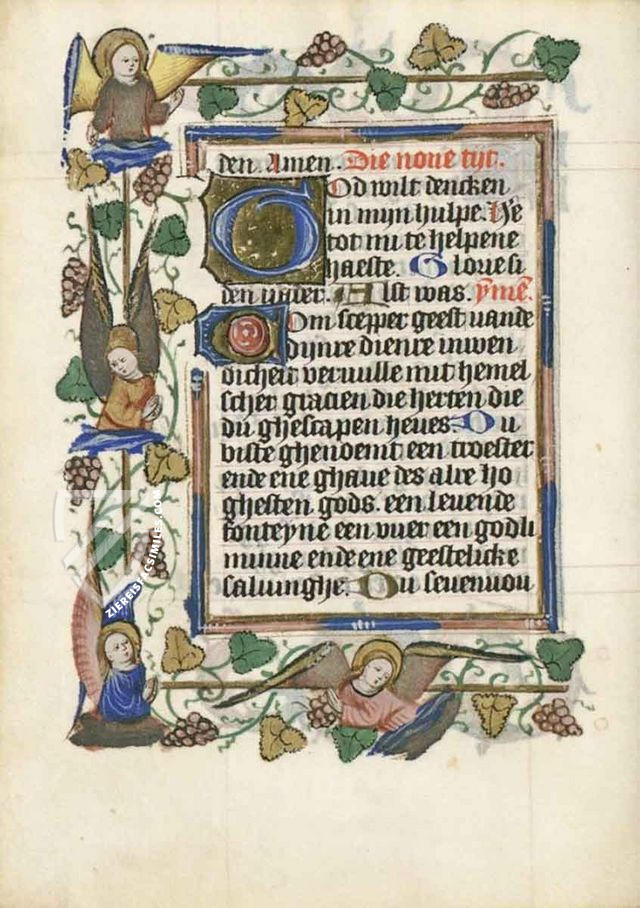
#1 Brewiarz Staroniderlandzki
Languages: English, Polish
(1,000€ - 3,000€)
- Treatises / Secular Books
- Apocalypses / Beatus
- Astronomy / Astrology
- Bestiaries
- Bibles / Gospels
- Chronicles / History / Law
- Geography / Maps
- Saints' Lives
- Islam / Oriental
- Judaism / Hebrew
- Single Leaf Collections
- Leonardo da Vinci
- Literature / Poetry
- Liturgical Manuscripts
- Medicine / Botany / Alchemy
- Music
- Mythology / Prophecies
- Psalters
- Other Religious Books
- Games / Hunting
- Private Devotion Books
- Other Genres
- Afghanistan
- Armenia
- Austria
- Belgium
- Belize
- Bosnia and Herzegovina
- China
- Colombia
- Costa Rica
- Croatia
- Cyprus
- Czech Republic
- Denmark
- Egypt
- El Salvador
- Ethiopia
- France
- Germany
- Greece
- Guatemala
- Honduras
- Hungary
- India
- Iran
- Iraq
- Israel
- Italy
- Japan
- Jordan
- Kazakhstan
- Kyrgyzstan
- Lebanon
- Liechtenstein
- Luxembourg
- Mexico
- Morocco
- Netherlands
- Palestine
- Panama
- Peru
- Poland
- Portugal
- Romania
- Russia
- Serbia
- Spain
- Sri Lanka
- Sweden
- Switzerland
- Syria
- Tajikistan
- Turkey
- Turkmenistan
- Ukraine
- United Kingdom
- United States
- Uzbekistan
- Vatican City
- A. Oosthoek, van Holkema & Warendorf
- Aboca Museum
- Ajuntament de Valencia
- Akademie Verlag
- Akademische Druck- u. Verlagsanstalt (ADEVA)
- Aldo Ausilio Editore - Bottega d’Erasmo
- Alecto Historical Editions
- Alkuin Verlag
- Almqvist & Wiksell
- Amilcare Pizzi
- Andreas & Andreas Verlagsbuchhandlung
- Archa 90
- Archiv Verlag
- Archivi Edizioni
- Arnold Verlag
- ARS
- Ars Magna
- ArtCodex
- AyN Ediciones
- Azimuth Editions
- Badenia Verlag
- Bärenreiter-Verlag
- Belser Verlag
- Belser Verlag / WK Wertkontor
- Benziger Verlag
- Bernardinum Wydawnictwo
- BiblioGemma
- Biblioteca Apostolica Vaticana (Vaticanstadt, Vaticanstadt)
- Bibliotheca Palatina Faksimile Verlag
- Bibliotheca Rara
- Boydell & Brewer
- Bramante Edizioni
- Bredius Genootschap
- Brepols Publishers
- British Library
- C. Weckesser
- Caixa Catalunya
- Canesi
- CAPSA, Ars Scriptoria
- Caratzas Brothers, Publishers
- Carus Verlag
- Casamassima Libri
- Centrum Cartographie Verlag GmbH
- Chavane Verlag
- Christian Brandstätter Verlag
- Circulo Cientifico
- Club Bibliófilo Versol
- Club du Livre
- CM Editores
- Collegium Graphicum
- Collezione Apocrifa Da Vinci
- Comissão Nacional para as Comemorações dos Descobrimentos Portugueses
- Coron Verlag
- Corvina
- CTHS
- D. S. Brewer
- Damon
- De Agostini/UTET
- De Nederlandsche Boekhandel
- De Schutter
- Deuschle & Stemmle
- Deutscher Verlag für Kunstwissenschaft
- DIAMM
- Droz
- E. Schreiber Graphische Kunstanstalten
- Ediciones Boreal
- Ediciones Grial
- Ediclube
- Edições Inapa
- Edilan
- Editalia
- Edition Deuschle
- Edition Georg Popp
- Edition Leipzig
- Edition Libri Illustri
- Editiones Reales Sitios S. L.
- Éditions de l'Oiseau Lyre
- Editions Medicina Rara
- Editorial Casariego
- Editorial Mintzoa
- Editrice Antenore
- Editrice Velar
- Edizioni Edison
- Egeria, S.L.
- Eikon Editores
- Electa
- Emery Walker Limited
- Enciclopèdia Catalana
- Eos-Verlag
- Ephesus Publishing
- Ernst Battenberg
- Eugrammia Press
- Extraordinary Editions
- Fackelverlag
- Facsimila Art & Edition
- Facsimile Editions Ltd.
- Facsimilia Art & Edition Ebert KG
- Faksimile Verlag
- Feuermann Verlag
- Folger Shakespeare Library
- Franco Cosimo Panini Editore
- Friedrich Wittig Verlag
- Fundación Hullera Vasco-Leonesa
- G. Braziller
- Gabriele Mazzotta Editore
- Gebr. Mann Verlag
- Gesellschaft für graphische Industrie
- Getty Research Institute
- Giovanni Domenico de Rossi
- Giunti Editore
- Graffiti
- Grafica European Center of Fine Arts
- Guido Pressler
- Guillermo Blazquez
- Gustav Kiepenheuer
- H. N. Abrams
- Harrassowitz
- Harvard University Press
- Helikon
- Hendrickson Publishers
- Henning Oppermann
- Herder Verlag
- Hes & De Graaf Publishers
- Hoepli
- Holbein-Verlag
- Houghton Library
- Hugo Schmidt Verlag
- Idion Verlag
- Il Bulino, edizioni d'arte
- ILte
- Imago
- Insel Verlag
- Insel-Verlag Anton Kippenberger
- Instituto de Estudios Altoaragoneses
- Instituto Nacional de Antropología e Historia
- Introligatornia Budnik Jerzy
- Istituto dell'Enciclopedia Italiana - Treccani
- Istituto Ellenico di Studi Bizantini e Postbizantini
- Istituto Geografico De Agostini
- Istituto Poligrafico e Zecca dello Stato
- Italarte Art Establishments
- Jan Thorbecke Verlag
- Johnson Reprint Corporation
- Josef Stocker
- Josef Stocker-Schmid
- Jugoslavija
- Karl W. Hiersemann
- Kasper Straube
- Kaydeda Ediciones
- Kindler Verlag / Coron Verlag
- Kodansha International Ltd.
- Konrad Kölbl Verlag
- Kurt Wolff Verlag
- La Liberia dello Stato
- La Linea Editrice
- La Meta Editore
- Lambert Schneider
- Landeskreditbank Baden-Württemberg
- Leo S. Olschki
- Les Incunables
- Liber Artis
- Library of Congress
- Libreria Musicale Italiana
- Lichtdruck
- Lito Immagine Editore
- Lumen Artis
- Lund Humphries
- M. Moleiro Editor
- Maison des Sciences de l'homme et de la société de Poitiers
- Manuscriptum
- Martinus Nijhoff
- Maruzen-Yushodo Co. Ltd.
- MASA
- Massada Publishers
- McGraw-Hill
- Metropolitan Museum of Art
- Militos
- Millennium Liber
- Müller & Schindler
- Nahar - Stavit
- Nahar and Steimatzky
- National Library of Wales
- Neri Pozza
- Nova Charta
- Oceanum Verlag
- Odeon
- Orbis Mediaevalis
- Orbis Pictus
- Österreichische Staatsdruckerei
- Oxford University Press
- Pageant Books
- Parzellers Buchverlag
- Patrimonio Ediciones
- Pattloch Verlag
- PIAF
- Pieper Verlag
- Plon-Nourrit et cie
- Poligrafiche Bolis
- Presses Universitaires de Strasbourg
- Prestel Verlag
- Princeton University Press
- Prisma Verlag
- Priuli & Verlucca, editori
- Pro Sport Verlag
- Propyläen Verlag
- Pytheas Books
- Quaternio Verlag Luzern
- Reales Sitios
- Recht-Verlag
- Reichert Verlag
- Reichsdruckerei
- Reprint Verlag
- Riehn & Reusch
- Roberto Vattori Editore
- Rosenkilde and Bagger
- Roxburghe Club
- Salerno Editrice
- Saltellus Press
- Sandoz
- Sarajevo Svjetlost
- Schöck ArtPrint Kft.
- Schulsinger Brothers
- Scolar Press
- Scrinium
- Scripta Maneant
- Scriptorium
- Shazar
- Siloé, arte y bibliofilia
- SISMEL - Edizioni del Galluzzo
- Sociedad Mexicana de Antropología
- Société des Bibliophiles & Iconophiles de Belgique
- Soncin Publishing
- Sorli Ediciones
- Stainer and Bell
- Studer
- Styria Verlag
- Sumptibus Pragopress
- Szegedi Tudomànyegyetem
- Taberna Libraria
- Tarshish Books
- Taschen
- Tempus Libri
- Testimonio Compañía Editorial
- Thames and Hudson
- The Clear Vue Publishing Partnership Limited
- The Facsimile Codex
- The Folio Society
- The Marquess of Normanby
- The Richard III and Yorkist History Trust
- Tip.Le.Co
- TouchArt
- TREC Publishing House
- TRI Publishing Co.
- Trident Editore
- Tuliba Collection
- Typis Regiae Officinae Polygraphicae
- Union Verlag Berlin
- Universidad de Granada
- University of California Press
- University of Chicago Press
- Urs Graf
- Vallecchi
- Van Wijnen
- VCH, Acta Humaniora
- VDI Verlag
- VEB Deutscher Verlag für Musik
- Verlag Anton Pustet / Andreas Verlag
- Verlag Bibliophile Drucke Josef Stocker
- Verlag der Münchner Drucke
- Verlag für Regionalgeschichte
- Verlag Styria
- Vicent Garcia Editores
- W. Turnowski Ltd.
- W. Turnowsky
- Waanders Printers
- Wiener Mechitharisten-Congregation (Wien, Österreich)
- Wissenschaftliche Buchgesellschaft
- Wissenschaftliche Verlagsgesellschaft
- Wydawnictwo Dolnoslaskie
- Xuntanza Editorial
- Zakład Narodowy
- Zollikofer AG

